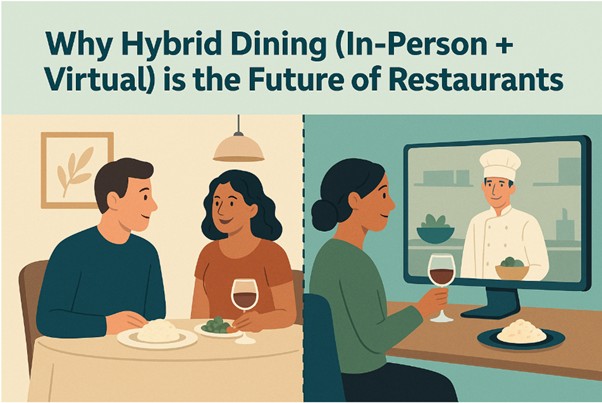
Why Hybrid Dining (In-Person + Virtual) is the Future of Restaurants
The restaurant industry is evolving faster than ever; hybrid dining is one of the most exciting trends shaping its future. This model blends traditional in-person dining with virtual experiences, online orders, and at-home kits. Post-COVID consumer expectations, digital innovation, and lifestyle changes have made hybrid dining possible and profitable.
Chef Shajahan M Abdul, founder of Restro Consultants Pvt Ltd (RCPL), says, “The restaurants that succeed tomorrow know how to serve both the guest at the table and the customer on the couch.”
In this new dining era, hybrid
experiences aren’t just an add-on—they’re the core of restaurant growth and
customer satisfaction.
What is Hybrid Dining?
Hybrid dining combines multiple
service channels under one brand:
Chef Abdul says, “Hybrid dining
means meeting your customers where they are—physically, emotionally, and
digitally.”
Why Hybrid Dining Is Gaining
Momentum
The restaurant industry faced
tremendous disruption during the pandemic. Out of that crisis emerged
innovation. Restaurants started offering curated boxes, virtual chef
interactions, and app-based loyalty programs, and customers loved them.
Today, hybrid dining is no
longer a pandemic response—it’s a strategic opportunity.
1. Customer Behaviour Has
Changed
Post-COVID, customers demand
flexibility. Some prefer eating out, while others want high-quality meals at
home that are convenient and comfortable.
Chef Shajahan M Abdul explains,
“One-size-fits-all doesn’t work anymore. Restaurants must be versatile to stay
relevant.”
Benefits of the Hybrid Dining
Model
1. Diverse Revenue Streams
By going hybrid, restaurants
don’t depend solely on foot traffic. Delivery, virtual events, and product
sales (like sauces or spice kits) provide alternate income streams.
Restro Consultants Pvt Ltd
(RCPL) helps restaurants build parallel revenue channels that reduce risk and
enhance cash flow.
2. Wider Audience Reach
Your physical space might limit
how many people you can serve, but hybrid offerings can reach thousands.
Whether through a meal kit delivery to another city or a virtual biryani
masterclass hosted online, the reach is global.
3. Stronger Brand Engagement
Virtual touchpoints—emails,
webinars, recipe blogs, YouTube cooking videos—keep your brand alive even when
the customer isn’t dining in. That long-term relationship is priceless.
Chef Abdul says, “With hybrid
dining, your brand becomes a daily part of your customer’s lifestyle—not just a
weekend visit.”
Hybrid Dining in Action: What’s
Working
Restaurants across India and
abroad are embracing hybrid with incredible results. Here are the most popular
formats recommended by restaurant consultants:
1. DIY Meal Kits
Restaurants package premeasured
ingredients with instructions for customers to recreate signature dishes at
home. This approach is interactive, fun, and scalable.
RCPL has helped multiple brands
in Mumbai and Delhi launch successful DIY meal kit lines that now account for
up to 20% of their monthly revenue.
2. Virtual Cooking Classes
Chefs go live on Zoom, YouTube,
or Instagram to teach recipes while viewers cook along. Some even charge a
premium for exclusive sessions.
Chef Shajahan M Abdul often
conducts such sessions for partner brands to increase visibility and
engagement.
3. Cloud Kitchen + Flagship
Dine-in
A restaurant can serve gourmet
dine-in customers while running a separate cloud kitchen brand from the same or
a nearby facility. It’s cost-effective and customer-focused.
Chef Abdul highlights that
hybrid doesn’t mean overextending—it means strategic diversification.
The Role of Technology in
Hybrid Dining
Technology is the glue that
holds hybrid dining together. From POS systems that manage dine-in and delivery
orders to CRM tools that personalize guest communication, every digital layer
adds value.
Restro Consultants Pvt Ltd
(RCPL) often integrates tools like:
Chef Shajahan M Abdul believes,
“Restaurants need tech as adaptable as their customers. Digital integration is
the foundation of hybrid success.”
Challenges Restaurants Face and
How to Overcome Them
1. Operational Complexity
Running a hybrid model means
managing different workflows—dine-in service, online sales, delivery logistics,
etc. RCPL helps streamline processes and trains staff to handle hybrid models
efficiently.
2. Brand Consistency
Ensuring a consistent
experience across physical and virtual touchpoints is tough. Chef Abdul
recommends centralizing quality control through SOPs and packaging design that
mirrors the dine-in feel.
3. Logistics and Supply Chain
Delivery partners, inventory
for meal kits, and packaging can complicate supply chains. Restaurant
consultants at RCPL assist with supplier onboarding, cost controls, and route
optimization.
Success Stories from the Hybrid
Frontier
These examples prove that
hybrid dining isn’t just possible—it’s profitable.
Final Thoughts from Chef
Shajahan M Abdul
Hybrid dining is more than a
trend—it’s the future of hospitality. Restaurants that embrace in-person warmth
and virtual convenience will thrive in the future.
As Chef Shajahan M Abdul puts it:
“Your customer is everywhere. The smartest restaurants? They follow.”
With guidance from experienced
restaurant consultants at Restro Consultants Pvt Ltd (RCPL), you can build a
hybrid model that increases revenue, improves efficiency, and future-proofs
your brand.
Chef Abdul © Copyright 2024. All rights reserved.